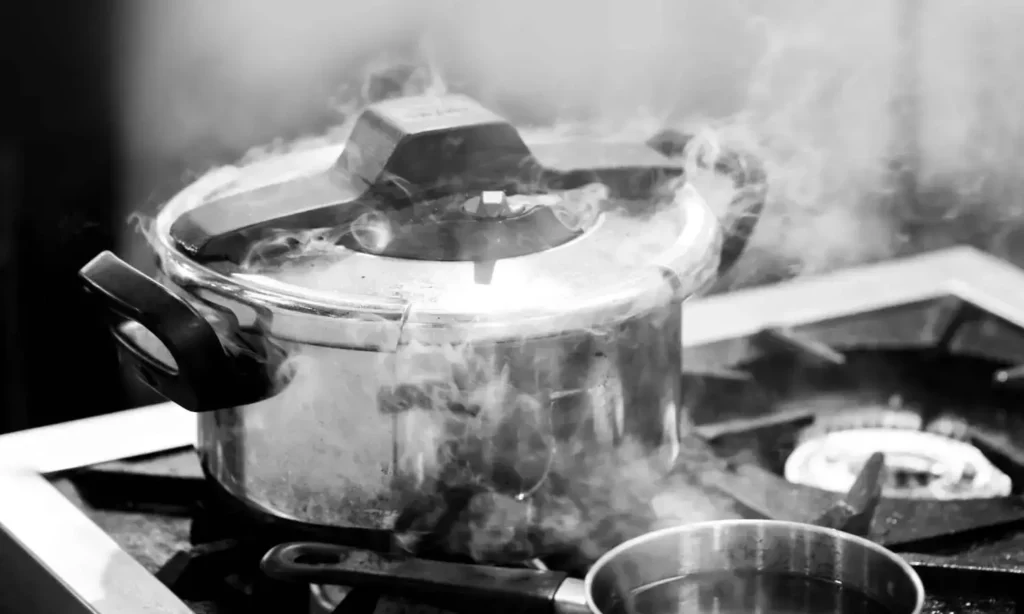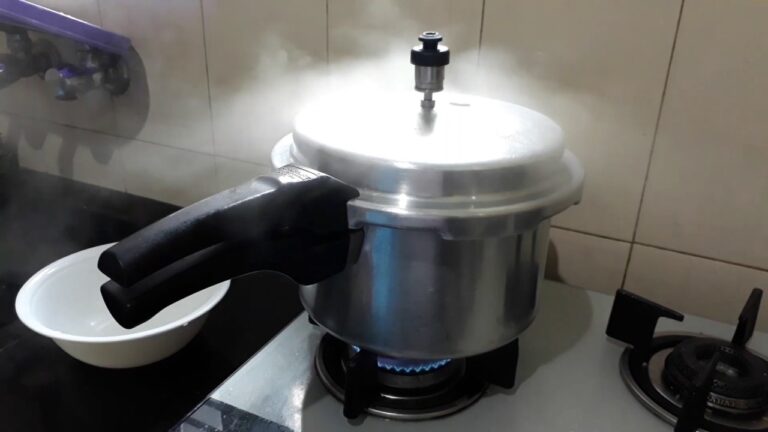When your pressure cooker sounds like a train, it could be due to various reasons. Often, it’s linked to the release of steam, issues with the pressure valve, or problems with the gasket. This noise is usually normal during cooking, but if it’s unusually loud or persistent, it’s worth investigating. Check the pressure valve, inspect the gasket, and ensure the sealing ring is in good condition.
However, regular maintenance, such as cleaning and checking for wear and tear, can prevent these train-like sounds. If the noise persists, seeking professional help may be necessary to ensure your pressure cooker operates safely and efficiently.
What Are The Causes Of Train-Like Sounds Of Pressure Cooker?

The train-like sounds produced by a pressure cooker can be attributed to several causes, often related to the mechanisms that regulate pressure and steam within the appliance. Here are some common causes
Steam Release Valve Issues
Blockages: Accumulation of food particles, mineral deposits, or other debris can obstruct the steam release valve. This obstruction can lead to irregular steam release, causing the characteristic train-like sound.
Valve Wear and Tear: Over time, the steam release valve may undergo wear and tear, affecting its ability to operate smoothly. This can result in noisy steam expulsion.
Sealing Ring or Gasket Problems
Wear and Tear: The rubber sealing ring or gasket, which is essential for creating an airtight seal, can deteriorate over time. If it loses its elasticity, it may not seal the cooker properly, leading to steam leaks and noisy operation.
Misalignment: If the sealing ring is not correctly aligned or if there is damage, it may not create a tight seal. This can allow steam to escape, causing audible sounds.
Pressure Regulator Issues
Improper Adjustment: The pressure regulator controls the pressure inside the cooker. If it’s not adjusted correctly or malfunctions, it can lead to erratic pressure changes and noisy steam release.
Debris Accumulation: Similar to the steam release valve, the pressure regulator can accumulate debris over time, affecting its function and causing noise.
Boiling or Vibrating Contents
Excessive Liquid: If there’s too much liquid inside the pressure cooker, it can lead to vigorous boiling and splattering, creating noise.
Food Residue: Food particles stuck to the bottom of the cooker can cause uneven boiling and rattling sounds.
Overheating or Rapid Temperature Changes
Insufficient Liquid: Inadequate liquid can lead to overheating, causing the water to evaporate rapidly and generate steam more forcefully, resulting in a train-like sound.
Sudden Temperature Changes: Rapid changes in temperature, such as opening the cooker immediately after cooking, can also cause steam to escape forcefully, creating noise.
Faulty Safety Features:
The safety valve is crucial for releasing excess pressure. If it malfunctions, it can result in loud steam release or even cause the safety valve to whistle like a train.
Why Does My Pressure Cooker Sound Like a Train?

Your pressure cooker may sound like a train due to issues like a blocked steam release valve or a worn-out sealing ring. Regularly cleaning and checking these parts can help fix the noise and ensure your pressure cooker operates quietly.
A step-by-step guide to identifying the source of the noise
Check Steam Release Valve: Verify that the steam release valve is free from blockages. Use a brush or a thin tool to clear any debris.
Inspect Sealing Ring or Gasket: Examine the sealing ring or gasket for wear, damage, or misalignment. Ensure it creates a proper seal.
Examine Pressure Regulator: Confirm that the pressure regulator is correctly adjusted according to the manufacturer’s guidelines.
Verify Safety Valve: Test the safety valve by gently lifting it; it should move freely. Replace if damaged or if movement is restricted.
Adjust Liquid Levels: Ensure you are using the recommended amount of liquid. Adjust if necessary to prevent excessive boiling.
Clean Interior: Regularly clean the interior, especially the bottom, to remove any food residues that might cause rattling sounds.
Descaling Heating Element: If applicable, descale the heating element to remove mineral deposits.
Avoid Rapid Temperature Changes: Allow pressure to normalize gradually before opening the cooker to prevent forceful steam release.
Common fixes for each potential cause
Steam Release Valve Issues:
Fix: Clean the steam release valve and the surrounding area regularly to prevent blockages. Replace the valve if it shows signs of wear.
Sealing Ring or Gasket Problems:
Fix: Replace the sealing ring if it’s worn or damaged. Ensure proper alignment during installation.
Pressure Regulator Issues
Fix: Adjust the pressure regulator according to the manufacturer’s guidelines. Clean the regulator to remove any debris affecting its function.
Boiling or Vibrating Contents:
Fix: Adjust liquid levels according to the recipe. Clean the interior to remove food residues.
Overheating or Rapid Temperature Changes:
Fix: Use the recommended amount of liquid to prevent overheating. Allow the pressure to normalize before opening the cooker.
Faulty Safety Features:
Fix: Test the safety valve regularly and replace if necessary. Follow the manufacturer’s guidelines for safety checks.
Safety considerations and precautions
Read the User Manual: Familiarize yourself with the user manual for your specific pressure cooker model. Follow all guidelines for usage, maintenance, and troubleshooting.
Power Off Before Inspection: Always turn off and unplug the pressure cooker before inspecting or attempting any maintenance. This ensures your safety.
Release Pressure Safely: Before opening the pressure cooker, release the pressure according to the manufacturer’s instructions. Avoid sudden opening to prevent steam-related accidents.
Use Genuine Replacement Parts: If replacement parts are needed, use genuine parts recommended by the manufacturer. This ensures compatibility and safety.
Seek Professional Help if Uncertain: If you are unsure about any troubleshooting step or if the issue persists, seek professional assistance. Do not attempt repairs beyond your expertise.
Regular Maintenance: Schedule regular maintenance following the manufacturer’s recommendations. This includes cleaning, inspection, and parts replacement as needed.
Monitor for Unusual Smells or Sounds: If you notice unusual smells or sounds during operation, stop using the pressure cooker immediately and investigate the issue. Unusual odors could indicate a malfunction.
Keep the Pressure Cooker in Good Condition: A well-maintained pressure cooker is less likely to develop issues. Regularly clean and inspect the appliance to ensure its proper functioning.
FAQ
Why is my pressure cooker crackling?
A crackling sound in a pressure cooker could be due to excessive heat or uneven boiling. Ensure you’re using the recommended liquid levels and clean the interior to prevent residue buildup, which can cause uneven boiling and noise.
How do I know if my pressure cooker is defective?
Signs of a defective pressure cooker include irregular steam release, persistent noise, or difficulty in maintaining pressure. If issues persist after troubleshooting, it’s advisable to consult the manufacturer or seek professional inspection.
What happens if you overcook in a pressure cooker?
Overcooking in a pressure cooker can lead to food becoming mushy or losing its texture. It’s essential to follow recipe guidelines and cooking times to avoid overcooking and maintain the quality of your dishes.
Is 2 cups of water too much for a pressure cooker?
No, it isn’t. The amount of water in a pressure cooker depends on the recipe. In general, 2 cups is a common starting point, but it’s important to follow the specific liquid requirements outlined in your recipe for optimal results.
Can you put salt in a pressure cooker?
Yes, you can add salt to a pressure cooker to enhance the flavor of your dishes. However, it’s recommended to follow recipe instructions for the appropriate amount to avoid over-seasoning.
Can you overheat a pressure cooker?
Yes, overloading a pressure cooker or using it without sufficient liquid can lead to overheating. This can result in noisy steam release and potential damage to the cooker. Always adhere to recommended guidelines.
What are the common pressure cooker problems?
Common pressure cooker problems include issues with the steam release valve, sealing ring, or pressure regulator. Regular maintenance, cleaning, and part replacements can address these problems and ensure smooth operation.
What happens if you don’t put water in a pressure cooker?
If you don’t put water in a pressure cooker it can lead to overheating and damage to the cooker. Water is essential for creating steam, which builds pressure. Operating a pressure cooker without water can pose safety risks and affect cooking efficiency.
Final words
In the end, if your pressure cooker sounds like a train, it’s likely due to issues with the steam release valve, sealing ring, or other components. By following simple troubleshooting steps and ensuring regular maintenance, you can quiet down your pressure cooker and enjoy efficient and noise-free cooking.

